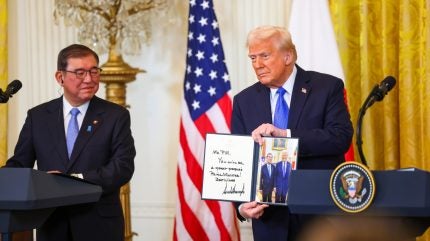
US President Donald Trump and Japanese negotiators have reached a trade deal that will lower the tariff rate on the Asian country’s imports into the US to 15%.
This is significantly lower than the 25% rate Trump announced in April, which was set to take effect next week. The deal includes a $550bn (Y80.54trn) investment pledge from Japan to the US, which, according to Bloomberg, a senior US administration official said would function as a sovereign wealth fund.

Discover B2B Marketing That Performs
Combine business intelligence and editorial excellence to reach engaged professionals across 36 leading media platforms.
The agreement also includes concessions for auto and rice sales. US cars and trucks built to US safety standards will not have to undergo additional checks in Japan. Japan will also increase rice purchases by 75% as well as buy 100 Boeing aircraft.
Japanese auto imports into the US will also be subject to the 15% tariff rate. The auto industry had represented a sticking point during negotiations.
Japan’s top trade negotiator, Ryosei Akazaw, said steel and aluminum, which are separately subject to a 50% tariff, are not included in the deal.
The $550bn investment pledge would be partly delivered through loan guarantees. While officials were previously said to be discussing a pledge of $400bn, the final figure – more than half a trillion dollars – would see Japan invest in projects in the US through instruments that would return 90% of the profits to America. These investments would focus on sectors that strengthen the US’ economic security, such as AI technologies, auto, critical minerals, energy, pharmaceuticals, semiconductors, shipbuilding and steel.

US Tariffs are shifting - will you react or anticipate?
Don’t let policy changes catch you off guard. Stay proactive with real-time data and expert analysis.
By GlobalDataWhite House Deputy Chief of Staff Dan Scavino posted a picture from the 75-minute final negotiation meeting between Japanese officials and Trump, where the President is seen holding a sign titled ‘Japan Invest America’ with a $400bn figure scratched out with $500bn written on top, ahead of settling on the $550bn figure.
“They had their top people here and we worked on it long and hard, and it is a great deal for everything,” Trump said of the meeting at a White House event on Tuesday evening (22 July).
The official who spoke to Bloomberg said an example of how the fund could work would be Trump selecting a project to be built with Japanese funds, of which the profits are then split 90-10. Where the Japanese funds would come from or what the investment timeline would be is unclear.
“The $550bn is a huge amount for Japan. It is going to take time, but Japan will need to invest in the US,” Alicia Garcia Herrero, chief economist for Asia-Pacific at Natixis, tells Investment Monitor. “Japan has a huge stock of investment already in the US, so this is not coming from nowhere.”
As the US tries to limit Chinese investments, Herrero also suggested that Japan and other regional partners like Taiwan could be well-placed to fill that vacuum. For example, in 2017, China and Alaska signed an agreement to develop a long-discussed liquefied natural gas pipeline in the state. As part of the deal with Japan, Trump said it would form a joint venture to develop the same $44bn project.
He also said that Japan would be given a safety clause on upcoming sector-specific tariffs, such as for semiconductors and pharmaceuticals. It means Japan would receive whatever the lowest global tariff rate for those industries is.
“Frankly speaking, I think this is good news for Japan because there has been a lot of underinvestment overseas because of a very cautious approach. I have had quite a few meetings with JBIC [Japan Bank for International Cooperation] in the last few years and Japanese overseas investment had been waning.
“So, this is in a way forced but good news for Japan because it is back in the game as a big investor,” Herrero says.





